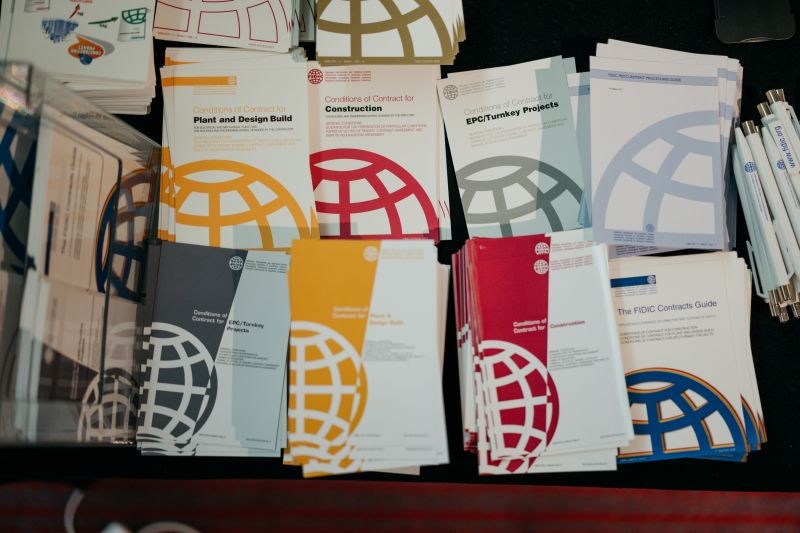Ahead of the 2025 FIDIC International Contract Users Conference in London on 1-4 December, we asked a group of lawyers from global law firm Pinsent Masons for their thoughts on some of the key legal and contractual issues currently facing the construction sector.
As one of the leading international law firms operating in the construction sector, what trends and challenges are you seeing currently when it comes to the contractual scene?
Sofia Parra Martinez, a partner from the Pinsent Masons Madrid office, focusing on construction disputes, noted that a key challenge was the reluctance of parties to shift away from the traditional EPC lump sum price model to more collaborative types of contracts, where there is greater risk sharing and more of a focus on shared project goals, open communication and problem-solving, as well as continuous improvement – including through suitable contractual incentives. In Spain, one of the main reasons for this, she said, is because both public and private clients have for a long time adopted the approach of contractors as single point of responsibility and a move into collaborative contracting models requires a change in both mindsets and procurement process that need time.
Greg Jones, a partner in the firm’s projects team in London, who has significant experience in the Middle East and Asia, has come across FIDIC contracts the most in the Middle East, where the original risk allocation is often turned completely upside down in a way that is hard to reconcile with FIDIC’s Golden Principles. “This is challenging for contractors because it can be difficult to get the necessary changes to the provisions implemented through negotiations, to better balance the contract,” Jones said.
Fréderic Gillion, based in Singapore, and on the President’s List of FIDIC Adjudicators, has seen the growing use of the 2017 suite of contracts – at least in some parts of the world. As an experienced partner across multiple jurisdictions, he notes that in some regions, such as Europe, there is still a predominant use of bespoke country forms or forms that are known to the country, while in the Middle East the 1999 forms are still favoured. However, in other regions the FIDIC 2017 forms have been adopted as a standard form of contract. In India, for example, all contractors are using the FIDIC 2017 contracts.
Edward Shaw, a partner in Pinsent Masons’ construction advisory and disputes team in London, said that Africa is another continent where the 2017 forms have been widely adopted, particularly in connection with World Bank-funded projects. “In other parts of the world where there has been less take-up, this might be put down to people’s lack of experience as to what those forms are designed to achieve relative to the 1999 forms and how the contracts are meant to be operated once entered into,” said Shaw.
Rob Morson, head of client relationships for the infrastructure and real estate sectors at Pinsent Masons and a projects lawyer, confirms this. “We’re also seeing FIDIC 2017 contracts used a lot more in project finance deals, where FIDIC core principles form part of the flow down provisions. That is appealing because it does make the contract easier to negotiate,” he said.
“In Africa, one challenge is that public entities have very constrained contracting procurement and execution mandates. As a result, they try to restrict the obligations or rights of the engineer, for example, to make determinations or to go to dispute adjudication boards by taking control over that process themselves. That doesn’t work, because there is often a fear within those public entities of being criticised for their decision or of getting something wrong – and this can lead to intransigence in decision making,” Morson explained.

Charles Blamire-Brown, construction advisory and disputes expert and head of department in London, highlighted that the energy boom that is going on in the UK, particularly in renewables, is driving the use of FIDIC contracts in a market where other standard form contracts have typically been used instead. “Many of the major tier one contractors used to using NEC contracts for big infrastructure projects, for example, are now having to get up to speed with FIDIC contracts for energy projects, including for pump storage hydro, data centres and battery storage projects, and this is reflected in the demand we’ve seen for training sessions from clients,” he said. “There is also a growing trend globally, as well as in the UK specifically, towards use of public private partnerships models and collaborative contracting, and it is encouraging to see FIDIC working on new forms of contract to reflect this” Blamire-Brown said.
Thomas King, a Pinsent Masons partner in South Africa, said that energy projects in this jurisdiction are driving a move to FIDIC contracts – although these are based on the 1999 forms rather than the 2017 suite. “That is probably due to the familiarity that local banks and investors given the number of EPC contracts and private IPPs they have been involved with,” he said.
Rena Scott, head of Pinsent Masons Saudi Arabia construction advisory and disputes team, said that contracts and projects are getting more and more difficult to manage in the Middle East, mostly due to complexity. “These problems can manifest themselves in specifications that do not tie-up to the FIDIC terms, which in turn can cause challenges in managing disputes. We also see a lack of real connection between the corporate ability to resolve a dispute, the delegation of authority – who within an organisation that has actual authority to manage disputes – and the dispute resolution provisions within the FIDIC contracts,” Scott said.
What issues do you think that the industry needs to be aware of going forward into the future?
From a global perspective, for businesses, collectively Pinsent Masons has seen that one of the major contractual issues that will impact is the extent to which force majeure-type clauses will evolve – and be interpreted – to reflect the new realities they are now operating in.
A good example, says Thomas King, is climate change and the realities faced by communities in African countries, in Central Asia and parts of Europe too, where sites have already been impacted by things like extreme heat, wildfires and major flooding. “In this context, as with imposition of sanctions, hyperinflation, or future pandemics, there is now a debate over what events can now truly be said to be unforeseeable. There is an opportunity for the drafters of standard form contracts to get ahead of this issue by developing sophisticated wording to help parties account for – and put a price on – related risks in their contracts,” King said.
Rob Morson added that the climate crisis and broader sustainability agenda – including as a result of associated underlying regulation – will also impact on the conditions funders will impose on their financing of projects. Beyond that, with digital transformation and increasingly connected infrastructure assets comes potential new uses of data – and associated challenges around data ownership and licensing, as well as data privacy and security.
How important are dispute boards on construction contracts and are they making a difference?
Frédéric Gillion explained that in his experience, if used as intended, dispute boards can be an essential tool in quickly resolving issues arising between parties during the course of a project, before they serve to derail a project, irretrievably souring relationships between parties, and requiring long and costly arbitration to resolve. “They have been of great use on projects I have advised on in central and eastern Europe, including in places such as Romania,” he said.

“The findings from the 2024 Dispute Boards International Survey by King’s College London, which Pinsent Masons colleagues helped develop the questions for, illustrate that the dispute boards can give parties a clear indication of what the outcome of disputes might be if they were to be heard in arbitration, which can promote compliance with their decisions rather than an escalation of matters, to the benefit of the parties and the project overall,” said Gillion.
Sofia Parra Martinez provided some local insights in Spain. “While dispute boards are not used in projects here, there is a growing trend of their use in Spanish-speaking Latin American projects,” she said. “The Madrid International Arbitration Centre is also considering issuing dispute board rules, like the ICC has, to cater for this. However, what I’ve heard so far in terms of dispute boards in Latin America is that lawyers tend to treat them as mini arbitrations and so the consequence in that jurisdiction seems to be, in my experience, that they are not as practical and collaborative as one would wish them to be,” she said.
Speaking from a Middle Eastern perspective, Jed Savager, a Pinsent Masons partner in Dubai focusing on construction advisory and disputes, noted that the real issue there is the cultural behaviour surrounding the use of dispute boards in the region. “The parties often don’t use them as they should be, there tends to be a reluctance to use them during the course of the project when disputes arise. As a result, disputes can stack up with boards often only being activated at the end of the Project at final account stage such that the process more closely resembles a mini arbitration. Whilst some procurers are now adopting standing boards in the region, which is to be welcomed, the majority still are ad hoc. Dispute boards are very seldom, in my experience, appointed during the project and we need a cultural shift to change that dynamic,” said Savager.
Chloé De Jager, a senior associate in the firm’s construction advisory and disputes team in the UK, with significant FIDIC related experience, saw this quite clearly in the African market too. “There’s a lawyer’s habit of turning a dispute adjudication board process into a mini arbitration. We’ve seen some examples where dispute boards have run for two, three, four years to resolve a dispute – that just cannot be the intention behind them. On the flip side, on the rarer of occasions, significant disputes can be properly and efficiently resolved within the standard 84-day period. Lawyers shouldn’t run shy on this – it can be done,” she said.
Rena Scott offered some insights in the Middle East too. “The reality is that, as long as the decision is not enforceable, in places like this, parties are seldom likely to pay out on the strength of an adjudicator’s decision. They will only do so on the say so of an arbitrator or a judge,” she explained.
Charles Blamire-Brown said that even where there is uncertainty around the direct enforceability of such decisions in certain jurisdictions, they can nevertheless confer soft power – because they can often encourage parties to consider a settlement where the decisions give a strong indication of how disputes might be resolved were they to proceed to arbitration. In the UK market dispute boards are not so common given the proliferation of statutory adjudication. “However we do so greater use of alternatives such as dispute boards or conflict avoidance panels on the larger mega projects in the UK market,” said Blamir-Brown.
Another big issue, however, is the shortage of suitable dispute board members that can be appointed at a regional level. “There is sometimes little merit in parachuting in an experienced international dispute board member to handle disputes if they lack the necessary regional expertise to have the trust of the local parties to resolve their dispute,” he said.

Why do you think that FIDIC contracts have enjoyed such enduring support in the industry globally?
The Pinsent Masons lawyers we spoke to were clear on the reasons for this support. “Quite simply, they’re the most flexible, adaptable, internationally appropriate suite of contracts in the world. They can be fit for any construction project of any type – whether it’s for offshore wind or data centres – in any geographic market. That’s the reason they’re used the most,” they said.
Pinsent Masons has been involved with FIDIC and its contracts for many years. What needs to be done to ensure that these contracts continue to be fit for purpose and keep pace with a fast-changing industry and regulatory scene?
The lawyers said that it was not possible to develop a standard contract that meets the requirements for every type of construction project in every part of the world. It is the flexibility of FIDIC contracts – the ability for parties to adapt the provisions to their needs – that makes them fit for purpose, they said.
According to Rob Morson, what organisations like FIDIC could do, though, is issue guidance notes more regularly around how parties should reflect new and emerging issues or technologies, or those that are specific to geographic markets, in their contracts. This would avoid the unenviable task of trying to develop separate, bespoke standard forms for, say, data centre projects and battery storage projects, but rather give parties a steer on how to meaningfully adopt the existing forms for use on such projects.
While we are not in the same world of globalisation that we were in in the 1990s or 2000s, the prospect of more guidance to help FIDIC contracts be adapted for specific projects was preferable to the alternative scenario where global construction companies have to familiarise themselves with bespoke contracts for every project or even country-specific standard forms.
Pinsent Masons has an enduring reputation for being leading advisors to the sector. Why do you think that is?
Charles Blamire-Brown said: “Clients see a team of construction lawyers – the largest such team globally of any firm (with c. 450 construction lawyers globally) – that has been there, seen it and done it for the last 40 to 50 years. The wealth of institutional knowledge on construction matters is unique in that regard and is reflective of a team used to working on megaprojects – throughout UK, Europe, Africa, Middle East, Central and Southern America, Central Asia and Asia Pacific. In the UK specifically, we have been front and centre of almost every major infrastructure project in the past 30 years, from the Channel Tunnel, Wembley Stadium, the London 2012 Olympics, to projects such as Crossrail, Thames Tideway Tunnel, HS2, Hinkley Point C and Sizewell C. That experience translates into a unique skill set and very strong credibility across our geographies worldwide.”
According to Rena Scott: “With my experience at other firms, I can safely say that there is no other firm like Pinsent Masons that has such a dedicated focus on construction internationally. Pinsent Masons is the only band one global construction firm in the Chambers rankings, which reflects the fact that we’re part of a team of serious individuals who care about this subject matter,” she said.
Edward Shaw said: “Construction, engineering and infrastructure projects are in the lifeblood of Pinsent Masons. As someone who only joined the firm last year, this was a major selling point. There are countless colleagues across the globe that demonstrate their deep sector understanding and legal and contractual expertise in their work every day.”
“Clients in Spain – the engineers themselves, not in-house lawyers – have told us that we speak the language of the construction industry, that we go into a degree of detail that other firms cannot conceive doing. We don’t stay on the surface of a contract,” said Sofia Parra Martinez.
Clients don’t have to educate us around the business of construction – we ‘get’ it,” said Rob Morson. “That’s because we have a large team of lawyers focused on construction including many colleagues who were previously built environment professionals themselves – and we ensure that their knowledge is shared and taught internally.”


















